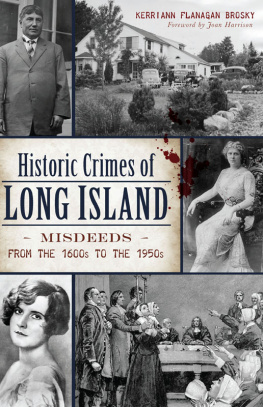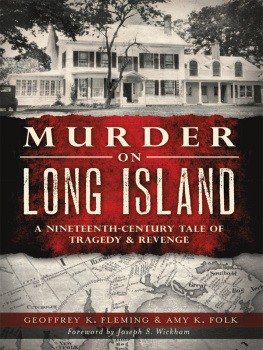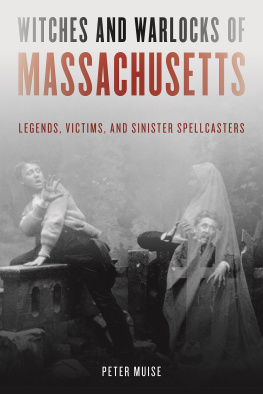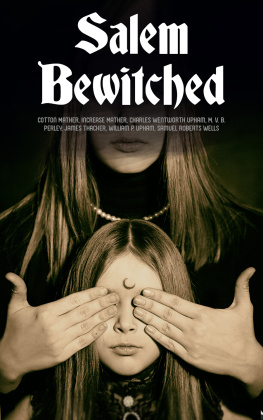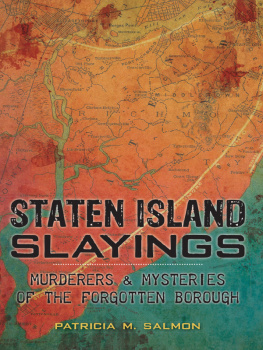

BOOKS BY KERRIANN FLANAGAN BROSKY
Delectable Italian Dishes for Family and Friends, coauthored with Sal Baldanza
Ghosts of Long Island: Stories of the Paranormal
Ghosts of Long Island II: More Stories of the Paranormal
Historic Haunts of Long Island: Ghosts and Legends from the Gold Coast to Montauk Point
Huntingtons Hidden Past
Huntingtons Past Revisited
The Medal, a novel

Published by The History Press
Charleston, SC
www.historypress.net
Copyright 2017 by Kerriann Flanagan Brosky
All rights reserved
First published 2017
e-book edition 2017
ISBN 978.1.43966.229.8
Library of Congress Control Number: 2017940948
print edition ISBN 978.1.46713.764.5
Notice: The information in this book is true and complete to the best of our knowledge. It is offered without guarantee on the part of the author or The History Press. The author and
The History Press disclaim all liability in connection with the use of this book. All rights reserved. No part of this book may be reproduced or transmitted in any form whatsoever without prior written permission from the publisher except in the case of brief quotations embodied in critical articles and reviews.
This book is dedicated to friend, colleague, former professor and history partner in crime Joan Harrison.
Contents
Foreword
The macabre, the deviant and the unexplained innately fascinate human beings. Crime stories both true and imagined have transfixed the populace from the illustrated Penny Dreadfuls of the nineteenth century to the myriad TV, cable and online series that form the most popular genre today. Indeed, if you look deeper, the Bible and the mythologies of various world cultures are filled with tales of heinous crimes and often explore the dark side of humanity.
In this book, Kerriann Flanagan Brosky presents twenty historical accounts of passion, murder and scandal that were reported in the tabloids of their day, provided fodder for local gossips and often bloodstained the very soil of our communities. This meticulous author investigates not only misdeeds and the events that led up to them but often the aftermath of the crime and its ramifications for society. These vignettes of transgression and wickedness run the gamut from a look at a hanging gone wrong that called into question capital punishment to the mysterious drowning of a beautiful young socialite that inspired the novel and subsequent movie Butterfield 8.
Kerriann Flanagan Brosky and I have been friends and cohorts in creativity for more than a quarter of a century. We were both mentored by the great photojournalist Arthur Leipzig, who taught us to use our cameras to take a deeper look at the human comedy as well as human tragedy. Both of us went on to apply the lessons we learned from him to our art, our writing and our lives, as well as our image making.
I met Kerriann when she was a young student in my freshman Foundation in Art class. She evidenced a maturity and attention to detail extraordinary for one so young and innocent. I watched as she matured, started her own business, had a family and became one of Long Islands best-loved authors. I enjoyed her local histories, her cookbook, her novel and her amazing books on ghosts and the supernatural. Kerriann was a frequent visitor to my art classes at LIU Post, where her accomplishments provided inspiration and set an example for the students.
Having compiled and written four local histories myself, in my research I frequently came across great stories that did not quite fit into the template I was working with. I knew from my lectures the public was eager and ready for literature that plumbed the depths of the human psyche, and I had to explain more than once why there were no murder stories included in my Images of America and Modern America histories. It was my great pleasure to share the hidden gems I found with Kerriann and watch as she dug for the deeper facts and wove them into tales that did and will thrill her readers.
In this book, the account of Captain James Crafts bone-chilling fate was one I found deep in the annals of the Brooklyn Daily Eagle and always wanted to see in print again. I am glad that Kerriann was equally captivated by this gold-toothed dandy and was able to rewrite the voluminous newspaper saga into something the modern reader can absorb. We are both glad that the actual depraved act itself took place in Manhattan and not too close to home for comfort!
During our discussion of the book, Kerriann mentioned that there were no photographs relating to some of the events that took place in the nineteenth and early twentieth centuries and that she needed to find an illustrator. Intrigued, I offered to put my brain and drawing hand to the task. It was quickly decided that pen-and-ink sketches in the tradition of the bloody Penny Dreadful style of illustration would be the most appropriate solution. As an artist who moves back and forth between the drafting table and the camera, this was not such a stretch for me. My first paying job in the arts was as an illustrator of news graphics for Channel 11 New York nightly news, in tabloid central, the Daily News building on Forty-Second Street. My second was in the WOR TV NEWS studio located over a porn theater in the heart of Times Square, which in the 1970s was one of the raunchiest, most crime-ridden areas of the city. This was the end of the era before computers and video, when Manhattan Island was still authentic and at its grittiest. News cameramen, like the early illustrators, were told to get shots of the blood on the sidewalks. If they came back empty-handed, the artists had to come up with a visual solution. Graphics of downed figures, blood spatters and guns were popular.
After years of teaching and making lush landscape pastels as a fine artist, it was great fun to get back to my early roots. It was both mind expanding and challenging to try to tell sometimes-complicated narratives in small monochromatic drawings. What was even more fun was that todays technology allowed me to add additional figures, clean up misplaced lines and edit the work on the computer, an option unavailable to artists when I began in the profession.
The kind of tragic and operatic parables of human wickedness and ill fate found in these pages have informed, educated and entertained people throughout the ages. I hope that you, as a reader, will settle into a big comfortable armchair by a fire to be amazed and chilled by them.
Joan Harrison
Professor Emerita, LIU Post
Preface
We should pass over all biographies of the good and the great, while we search carefully the slight records of wretches who died in prison, in Bedlam, or upon the gallows.
Edgar Allan Poe
Why are people fascinated with crimes? Every day our newspapers are filled with stories of true crimes. Crimes are also fictionalized in novels, with murder mysteries being one of the top literary genres. So what is it about these tales of tragedy, murder and crimes of passion that has us glued to every word we read on the page?
As humans, we are inquisitive about everything, especially things we do not understand, like what motivates another person to commit a heinous act. What is it that leads someone to murder a person out of jealousy, anger or rage? It is difficult for us to comprehend these things. We are also interestedor maybe nosy is a better choice of wordsin what goes on in other peoples lives. When we read about crimes, we find out what goes on behind closed doors. How shocking it is when we find out someone has been having an affair or a respectable member of the community committed murder. We become obsessed with
Next page
